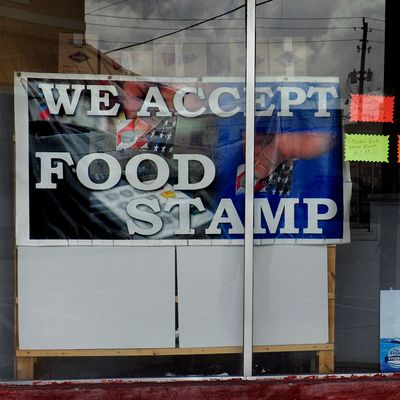
Donald Trump’s sins are so plentiful that they battle constantly for condemnation. Each week brings some fresh outrage: a new crime, or new information about an old crime, or another example of his hostility for anyone who does not resemble his mostly white, mostly male, relatively well-off base. Inevitably the news drowns out whatever came before it so we are reduced to ticking off a list to remember the truth. Yes, two dozen women have accused him of sexual harassment and assault. Yes, he is racist. Yes, he is corrupt. And yes, he hates the poor.
It is not unusual for a Republican administration to seek cuts to welfare. It’s not even totally out of character for a Democratic president to do the same. (Triangulation, as practiced by Bill Clinton, had its victims.) But Trump has pursued this objective with remarkable vigor, and the USDA’s new food-stamp rule, out today, is proof.
Significant restrictions on food-stamp eligibility predate the Trump presidency. The related ideas that the poor are poor because they are lazy, and that they deserve to go hungry, are written into existing work requirements for the Supplemental Nutritional Assistance Program. Able-bodied people who are not caring for dependants can only receive food stamps for a period of three months in three years, unless they prove they are working at least 20 hours a week or attending school or vocational training. States can lift these rules for areas in economic crisis. If local unemployment is 20 percent above the national average or more, residents benefit from expanded SNAP eligibility. But the White House now wants to shrink this loophole to a pinprick.
As the Wall Street Journal reported on Wednesday morning, states can now only apply for waivers if local unemployment hits 6 percent. The change will cut off food aid for an estimated 755,000 people, and it’s also only the first of three changes the USDA proposes for SNAP. Another proposal, which the USDA is likely to finalize, would take food stamps from another 3 million people. Right now, households with incomes up to 200 percent of the federal poverty level can receive food stamps. The New York Times explained, for reference, that this guideline extends food aid to families of four with a household income of about $50,000. Households with assets of at least $2,250 would also no longer be eligible for aid. The USDA itself has admitted that its reforms would cost almost half a million children their free school lunches, since eligibility is often determined by a household’s receipt of food stamps. The Urban Institute has estimated that the administration’s three rule changes, if finalized, will deprive around 3.7 million people total of food aid.
The administration has said its proposals would cut $4.5 billion from the USDA’s budget, and would limit food assistance to those who truly need it. But hunger is already a national problem. The USDA’s own data show that over 14 million Americans suffered food insecurity in 2018. Social media is replete with outrage over school districts denying children hot meals over unpaid lunch debt. And while it’s true that unemployment is low, wage growth is still out of pace with inflation, and rising costs of living add further pressure on families in need. Work, in other words, does not necessarily keep the lights on, or fill empty bellies. Not that it should really matter. A straight line connects the notion that some forms of poverty are more acceptable than others to proposals like the one the USDA finalized today.
While this is not the first time the American government has told its poor to work and starve, it is quintessentially Trumpian to do so less than three weeks before Christmas. “If I become president, we will be saying Merry Christmas again,” Trump vowed on the campaign trail. Maybe it’s merry for him, and for USDA Secretary Sonny Perdue. But hundreds of thousands of people will now struggle through the holiday season with dread.






























